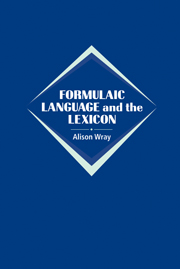Book contents
- Frontmatter
- Contents
- List of Figures and Tables
- Preface and Acknowledgements
- Part I What Formulaic Sequences Are
- Part II A Reference Point
- Part III Formulaic Sequences in First Language Acquisition
- Part IV Formulaic Sequences in a Second Language
- Part V Formulaic Sequences in Language Loss
- 12 Patterns of Formulaicity in Aphasic Language
- 13 Formulaic Sequences in Aphasia: A Model
- Part VI An Integrated Model
- Notes
- References
- Index
12 - Patterns of Formulaicity in Aphasic Language
Published online by Cambridge University Press: 07 October 2009
- Frontmatter
- Contents
- List of Figures and Tables
- Preface and Acknowledgements
- Part I What Formulaic Sequences Are
- Part II A Reference Point
- Part III Formulaic Sequences in First Language Acquisition
- Part IV Formulaic Sequences in a Second Language
- Part V Formulaic Sequences in Language Loss
- 12 Patterns of Formulaicity in Aphasic Language
- 13 Formulaic Sequences in Aphasia: A Model
- Part VI An Integrated Model
- Notes
- References
- Index
Summary
Introduction
Aphasia is a term used to describe a number of different kinds of disruption to language following damage or surgery to the language-dominant hemisphere of the brain (usually the left). People with aphasia offer some insights into the nature of formulaic sequences which it would be difficult to obtain from those whose language-processing faculties are functioning normally. Formulaic, or automatic, language has long been recognized as a key feature of aphasia, and indeed it was being described in the medical literature long before it was identified by linguists as a significant component of normal language (see Benton & Joynt 1960, Critchley 1970 and Espir & Rose 1970:24ff for historical overviews). Case studies of aphasic patients date back several centuries, and in the twentieth much detailed work was made possible by the localized brain injuries of otherwise healthy young men returning from war (e.g., Goldstein 1948; Head 1926; Russell & Espir 1961). Accounts characteristically highlight as a curiosity the survival of some lengthy sequences even when very little other language remains. In one of the earliest published reports, from 1683, Peter Rommel wrote of an aphasic woman:
she lost all speech with the exception of the words ‘yes’ and ‘and’: She could say no other word, not even a syllable, with these exceptions: the Lord's Prayer, the Apostle's Creed, some Biblical verses and other prayers, which she could recite verbatim and without hesitation, but somewhat precipitously. […]
- Type
- Chapter
- Information
- Formulaic Language and the Lexicon , pp. 217 - 246Publisher: Cambridge University PressPrint publication year: 2002



